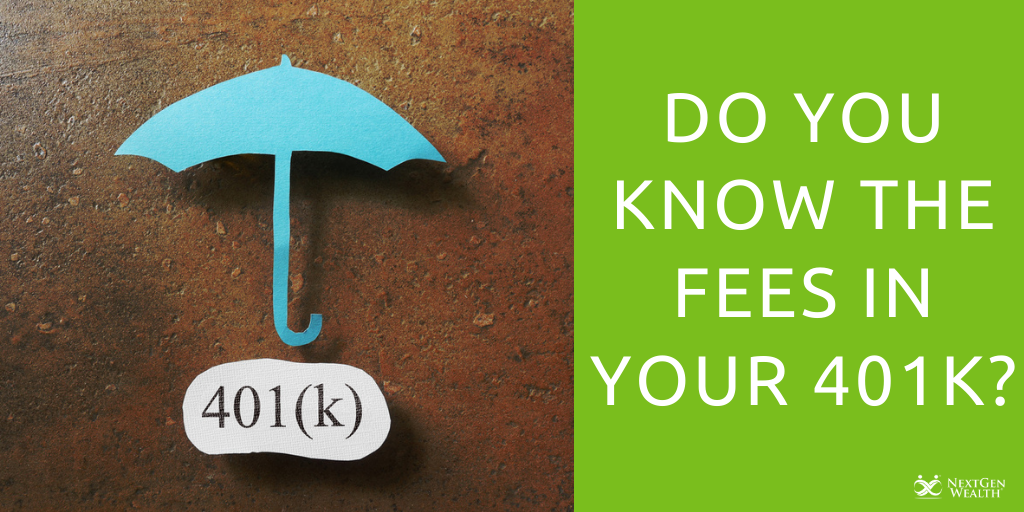Do You Know the Fees in Your 401k?
We all love our retirement accounts. Saving for the future gives us something to look forward to and reminds us how our hard work will pay off down the road. 
A 401(k) is one of the most popular and common types of retirement plans we have access to today.. By diverting money from our paycheck into our 401(k), the goal is to save enough so that by the time we retire, we can live comfortably without a change in lifestyle.
However, what most people don’t realize is that they’re actually paying fees within their 401(k). Potentially a lot more than you might think...particularly for smaller 401(k) plans.
Roughly only a quarter of investors know the exact amount of fees they pay in their 401(k). And, more than a third didn’t even know that they paid any fees. This is because most of the fees are deducted from the account balance and investments automatically i.e. you never see them but, trust me, they’re coming out.
Despite the apparent lack of awareness regarding fees, all providers must disclose any and all fees. The U.S. Department of Labor requires the disclosure of all fees in an annually updated prospectus. However, most (normal) people are never going to take the time to read a 100 page prospectus.
Overall, most fees go towards running the administration of the 401(k) and the internal expenses of the mutual funds offered.
401(k) 101
Before recognizing the fees associated with your 401(k), familiarize yourself with the basics. Make sure you understand the benefits of a 401(k), and speak with a financial advisor to help select the best investments for your particular needs.
Employers offer 401(k) plans to their employees as an additional benefit. In most cases, both the employer and employee contribute to the account. To get the most out of your 401(k), understand the contribution limits so that you fully prepare yourself for the best retirement possible. Here’s a look at the 2021 401(k) contribution limits.
Typical 401(k) Fees
12B-1 Fee
Technically labeled a marketing and distribution fee, the 12B-1 reared its head with the Investment Company Act of 1940. While typically between 0.25 percent and 0.75 percent of a mutual fund’s net assets, the 12B-1 fee sometimes peaks at the maximum allowed one percent. The 12B-1 was intended to attract additional investors to a mutual fund upon its origination.
More investors should mean lower overall operating costs for the mutual fund provider. However, many criticize the fee as an unnecessary expense to the account holder. The SEC began investigating the 12B-1’s legitimacy in 2015.
Class B and Class C mutual fund shares typically contain a 12B-1 fee. Although not as common, they also appear in Class A shares as well. When applied to distribution, the fee covers payment for brokers selling the shares. Other expenses covered include marketing, mailing information to account holders including the annual prospectus, legal fees, accounting fees and other kinds of similar expenses.
Check your annual prospectus to determine whether the mutual funds within your 401(k) include a 12B-1 fee, as well as its percentage. If they do, then I would highly recommend speaking with your administrator to see about replacing those funds with ones that don’t have 12b-1 fees.
Management Fees
Administering a 401(k) or any other kind of mutual fund takes time and effort. The 401(k) administrator will get some type of management fee and the mutual fund managers will also have their internal expenses as well.
The fee amount varies depending on the administrator and funds offered. Typically, management fees range from 0.10 percent to two percent of all assets under management.
Management fees make sense in relation to their service but more fees don’t necessarily mean better/more service or better performance. Actually, quite the opposite in most cases.
Penalties
The IRS designates 401(k) accounts as taxed advantaged, meaning that the account holder pays no taxes until they withdraw the funds. Early withdrawal, however, results in both taxation and penalties. Roth 401(k) plans offer tax free withdrawals because the account holder pays taxes before making their contributions.
To learn more about the different types of 401(k)s, check out the differences between traditional 401(k) accounts and Roth 401(k) accounts.
In certain cases, 401(k) account holders need to withdraw funds early to cover unexpected financial burdens. Called hardship withdrawals, a penalty of 10 percent of the total value of the assets withdrawn is applied when the account holder withdrawals the money before they reach 59 ½.
401(k) Taxes
You must pay taxes from your traditional 401(k) withdrawals like regular income. The tax rates vary from 10 percent for withdrawals up to $9,325, all the way up to 39.6 percent for withdrawals over $418,401 by single filers. You can check out a tax chart here to visualize and predict your tax rate.
However, always consult your financial advisor to fully understand tax rates associated with your withdrawals and filing situation. Financial planning during retirement ensures prolonged protection from uncertainty.
Fees Paid by Employers
When enrolling in a 401(k) offered by your employer, either party may pay the associated fees. Yes, you read that right. Your employer may pay your 401(k) fees.
However, less than one in five employers pay the fees associated with their employees’ 401(k) accounts. Possibly, employers and employees can reach an agreement to share the associated retirement plan fees. When looking for an employer offering a retirement plan, discuss the possibility of fee coverage during negotiations.
Know Your Fees
Whenever entering into a 401(k), or any other kind of retirement plan for that matter, spend time understanding all the associated fees. If you don’t have the time or knowledge, consult with a trusted financial advisor who can help you better understand your 401(k) so you’re making the best decision.



